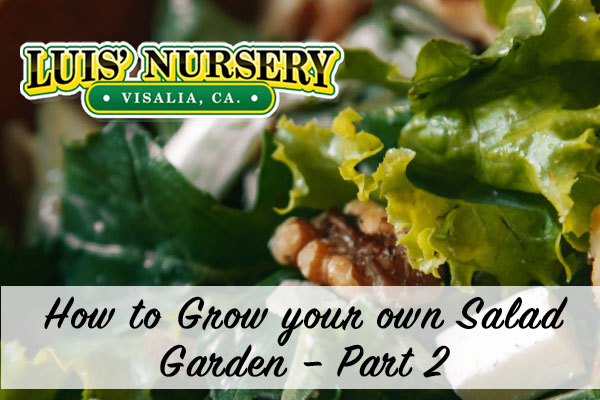In the previous article we discussed what a salad garden is, how to choose the right seeds for your garden and how to plan for a successful garden. What else do you need to know about creating a successful salad garden?
How often should you reseed?
How do you keep a salad garden growing? After you’ve harvested or ‘mowed’ your lettuce bed your soil will now be exposed and it’s the best time to water the soil to assist the leaf mass in the beds to act as mulch. It’s important at this stage to reseed often. Scatter seeds among your existing plants and water often. The newer seeds won’t grow as quickly in the shade of the larger plants, but eventually you will cut down the older plants that are beginning to exhaust and attempting to flower. This will make space for your newer plants without disturbing the root systems in the beds by pulling out the older plants.
How do you make sure the garden remains successful?
It’s important to seed for your season. The seed mixes should be seasonally appropriate. In the fall you will want to use cold hardy mixes for the long winter growing season. In the summer you will want to use slow-bolting seeds and in spring early germinators are your pick. It’s also important to rotate your beds. Your bed will be depleted of nutrients and will put out the welcome mat for unwanted pests. Rotate your bed each year and only use the same bed once every 4 years for the best results.
How do you grow the seasonal salad fixings?
We all know just having lettuce alone doesn’t make for a very exciting salad. Lettuce alone what fixings do you like with your salad? Many enjoy having tomatoes, radishes, and cucumbers with their salads. When planning your salad garden, you will want to plan for continuous or extended harvesting.
- Herbs – A salad, as any dish, is always enhanced by fresh herbs. Basil, cilantro and dill are some favorites among herbs. French tarragon and Mexican marigold can add some amazing flavor as well. Basil will produce for long periods during hot weather and if you keep harvesting it will encourage continued leaf growth. If you choose to grow lettuce leaf basil it will have more mass and milder flavor. If you choose to plant dill and cilantro you should plant them earlier in the season as their taste is improved by cooler weather.
- Edible flowers – Nasturtiums, chive, arugula, borage, hollyhocks, mustard, squash, dandelion flowers and clover as well as chives, oregano, and lavender flowers all make for fun edible flower additions. Nasturtiums are perfect for warm weather, and you can even eat the leaves. You can also use sunflowers as a table dressing and you can roast the seeds and use them in your salads as well.
- Tomatoes – Nothing beats garden fresh tomatoes. Even those of us that may not find tomatoes as appealing can be turned around by the flavor of a fresh garden plucked tomato. The type of tomato you choose will determine how often they produce. Some produce all at once and others produce heavily over a long period of time. Smaller tomatoes produce earlier and faster than larger ones. If you’d like to have regular harvest, choose to plant some cherry tomato bushes.
- Radishes – Cherry radishes require 35 days to grow. Replant regularly to keep them coming.
- Cucumbers – Choose the cucumber variety that will have the right tenderness as well as longer production periods.
These are just a few of the items you can add to your salad garden, and we are sure that you have your favorites. Taking the time to grow your own salad will tantalize your taste buds and make the salad experience even more fulfilling. If you have any questions about how to grow your favorite salad fixings, we’d be happy to help.



